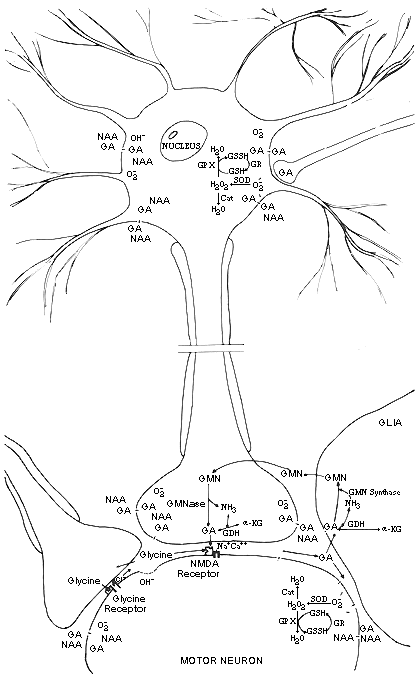
| Figure 2 |
 |
| Diagram showing a hypothetical glutamatergic corticospinal neuron forming a synapse with a hypothetical motor neuron. In primates, corticospinal fibers, originating from motor cortex areas, can form direct connections with spinal cord motor neurons, particularly with those innervating distal muscles of the extremities (26). Glutamate (GA) released from the glutamatergic terminal during neurotransmission is thought to bind to postsynaptic receptors, one of which, the N-methyl-D-aspartate (NMDA) receptor, is shown schematically. The NMDA receptor mediates excitatory transmission by activating the Na+ channel, which is also highly permeable to Ca2+. Synaptic glutamate is inactivated by uptake, primarily into the surrounding astrocytes (GLIA) where it can be converted to glutamine (GMN) via glutamine synthase or be metabolized to a-ketoglutarate (a-KG) via glutamate dehydrogenase (GDH) or via glutamate oxaloacetate transaminase. Astrocytes may then supply the nerve terminal by glutamine and/or a-KG, both of which can serve as precursors of transmitter glutamate (66). Glycinergic interneurons are also known to innervate motor neurons. Glycine, present at high concentrations in the vicinity of the NMDA receptor, is expected to potentiate glutamatergic transmission by acting on a strychine-insensitive allosteric site of the NMDA receptor. Glycine seems to increase the frequency of the NMDA receptor channel openings by accelerating the recovery of the receptor from glutamate-induced desensitization. There are indications that in primary (sporadic) ALS, intracellular glutamate stores are depleted and extracellular levels are increased. A number of primary defects, capable of causing increased membrane permeability with resultant leakage of glutamate, NAA, and other compounds to the extracellular space, may be operational. Patients with familial ALS have mutations of Cu/Zn SOD, a cytosolic enzyme involved in the elimination of superoxide radicals (O -) produced intracellularly during certain oxidation reactions. Non-detoxified O -2 may cause lipid peroxidation with resultant increased membrane permeability. Leakage of glutamate to the extracellular space is expected to enhance excitatory transmission mediated by glutamate receptors. Under such conditions of increased synaptic glutamate, desensitization of the NMDA receptor may be essential for protecting postsynaptic neurons from excitotoxic damage. However, the presence of high levels of glycine in the spinal cord and brainstem may prevent these adaptive processes, leading to abnormal potentiation of excitatory transmission and selective degeneration of motor neurons. a-KG, a-ketoglutarate; Cat, catalase; GA, glutamate; GDH, glutamate dehydrogenase; GMN, glutamine; GMNase, glutaminase; GPX, glutathione peroxidase; GR, glutathione reductase; GSH, reduced glutathione; GSSG, oxidized glutathione; NAA, N-acetylaspartate; SOD, superoxide dismutase. |
| Back to Chapter |
published 2000